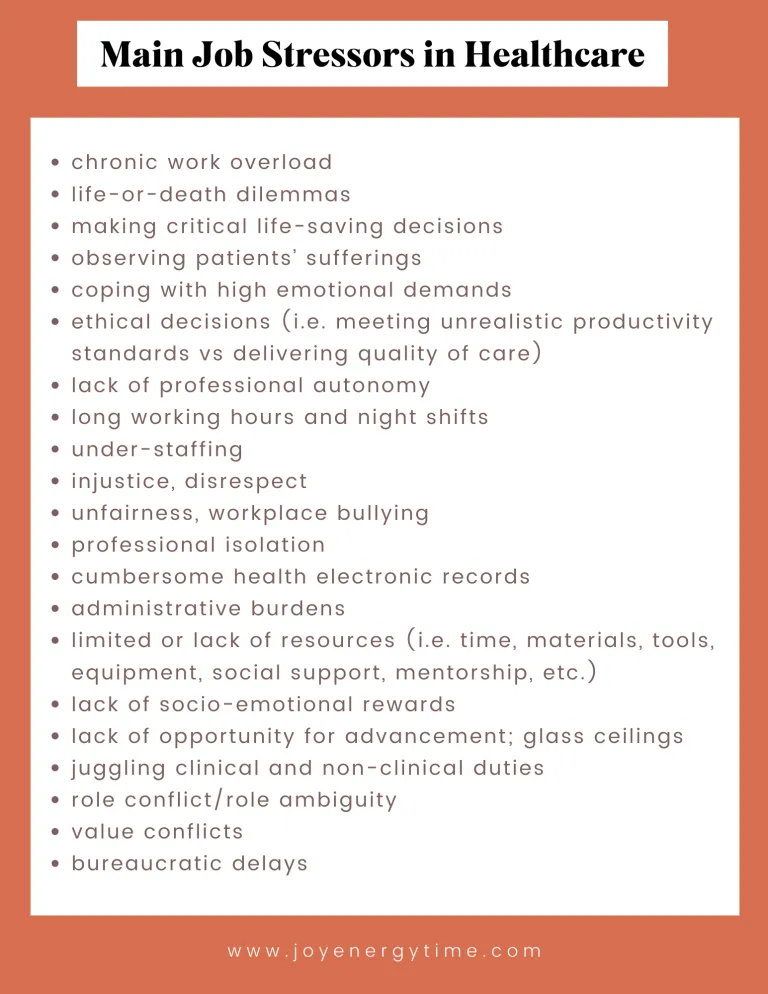Burnout in healthcare- not new news, right?
The problem of burnout in healthcare has only gotten worse by the COVID-19 pandemic, along with other experiences like compassion fatigue and trauma.
The surge of burnout in healthcare has become a public health crisis. It can be felt across various disciplines and fields within the healthcare industry, beyond just physicians and nurses.
Despite all the hype (for better or for worse) burnout has received over the last few years, the phenomenon is more than just a millennial-invented problem or an over-exaggeration of the stress of ‘adulting’.
Burnout in Healthcare is Not a Millennial Problem
It’s a problem backed by decades of research (thanks Christina Maslach and Michael Leiter!) disturbing our modern work world that requires urgent attention.
I’m passionate about burnout education and I have taught continuing education courses on the subject. In this piece I cover some of the major points from my continuing education course I taught with MedBridge Education titled Burnout in Health Care: Causes, Impact, and Solutions.
Now let’s look at what some of the latest research reveals about burnout in healthcare so that we can better understand how this problem has plagued the healthcare industry.

The Basic Breakdown of Burnout
What is burnout and what is it not?
Let’s start off with what it’s NOT. It’s not the same thing as being stressed out or having a bad day. You can face bouts of high stress throughout your career but never experience burnout.
That’s because…
Burnout results from a prolonged response to chronic interpersonal stressors on the job. ₁ The ICD-11 classifies burnout as an occupational phenomenon. It can be measured by these three main symptoms: emotional exhaustion, increased cynicism, and decreased self-efficacy.
See how chronic is highlighted? It doesn’t happen overnight. Moreover, an overwhelming amount of national studies have indicated that burnout has reached sky-high levels among healthcare workers. Why is that?
Major Causes of Burnout in Healthcare
Burnout in healthcare happens because physicians, nurses, and other healthcare workers are subject to high levels of occupational and psychological stress. The stressors of the job may include the following (but certainly not limited to):

…And Then The Pandemic Hit
The COVID-19 outbreak overwhelmed healthcare systems worldwide. As one of the most severely hit nations, Italy dealt with high patient overload. As a result, the Italian healthcare workforce experienced difficulties in coping with the challenges.
A total of 376 Italian participants that directly assisted COVID-19 infected patients participated in the study. They filled out a questionnaire including the Maslach Burnout Inventory (MBI). This assessment is considered the gold standard of measuring burnout among healthcare workers and workers in other industries. ₄
Higher levels of burnout were associated with a more frequent experience of symptoms. Furthermore, symptoms include: increased irritability, changes in food habits, difficulties falling asleep, muscle tension, exaggerated reactions to situations, nightmares, nervous breakdown, increased sweating, upset stomach/GI problems, palpitation, experienced inexplicable physical sensations, shortness of breath, and vertigo.
For the most part, both higher levels of the Emotional Exhaustion and Depersonalization categories were linked with more frequent experiences of symptoms listed above.
NOTE:For more COVID-19 resources, check out this piece about processing COVID-19 and read the stories and experiences of healthcare professionals when the pandemic began to unfold. You can also download free well-being resources for healthcare professionals in this COVID-19 Bundle.
The True Underpinnings of Burnout
Depending on which survey you look at, an alarming amount of healthcare professionals experience burnout.
What you see when you look at someone experiencing burnout is a byproduct of an actual underlying problem. When we look at someone with burnout, we see the emotional exhaustion, loss of confidence, loss of professional identity, sleep disturbances/insomnia, and depression to name a few.
#NotSoFunFact
In addition, when facing constant stressful situations, healthcare workers are more likely to demonstrate drug and alcohol abuse when compared to others in different work categories. For example, this abuse can be used as a relaxant, tranquilizer, or as a form of evasion. ₂
On the whole, we look at these symptoms and try to alleviate them. We think that will fix the real problem. Although alleviating the pain of the symptoms carries importance, you must appropriately address the source of the problem by tackling the metaphorical iceberg underneath the surface.
In this case, the iceberg underneath the surface is analogous to a dysfunctional workplace environment- the breeding grounds of burnout.

The Solution is Not Resilience Alone
Too often, the attention is so focused on the individual that the ‘solution’ has become all about personal strategies. For example, building resilience, setting boundaries, taking a vacation, snack breaks, relaxation techniques, self-care, etc.
These resources DO prove to be substantial in protecting healthcare workers’ health and well-being in the long-term. However, these strategies ALONE do not negate the need for organizations to fix the systemic issues and cultures that perpetuate the problem in the first place.
In fact, work-directed approaches combined with person-directed approaches lead to longer-lasting beneficial effects for healthcare workers in a skilled nursing setting. Work-directed approaches include changes to the work environment, work tasks, and/or working methods. ₅
The Formula for Burnout
Every job has both demands and resources. There are two psychological processes going on here: the stress process and the motivational process. ₃
The stress process involves excessive job demands that can lead to absenteeism, poor performance, and poor organizational commitment. The motivational process involves an abundance of job resources, which in turn promotes work engagement and positive work performance.
Subsequently, burnout in healthcare can be best described by an imbalance between demands and resources. Facing high and even unrealistic demands combined with having insufficient resources- like time- to meet those demands is a recipe for disaster.
The Job-Demands Resource Model argues that high demands and low resources can lead to greater levels of stress and burnout.
Hence, this is the equation you get:
High demands + Low Resources = Greater likelihood of burnout
Demands can take many forms and is not always apparent. For example, when we think ‘high demands’ we may think of an overwhelming workload that prevents a healthcare worker from being able to recuperate. Thus, this depletes their emotional resources.
Not only is that true, but there are also other types of demands.
The pressure of productivity standards and performance metrics have stripped healthcare workers of their autonomy, or the degree to which the job provides substantial freedom, independence, and discretion to the individual in determining the procedures used in carrying out work.
Admittedly, the considerable barriers to practicing at top of license can result from the burden of completing administrative tasks. This is done in order to check off the boxes and satisfy insurers.
The Hypocrisy of Preaching Patient-Centered Care
Many healthcare organizations pride themselves in providing “patient-centered care.” Do organizations truly practice what they preach, or is it all a ruse? Do money metrics and patient-centered care truly go hand-in-hand?
Deciding what’s best for the patient and using your knowledge and clinical reasoning may significantly clash with the expectations of how you perform work. In turn, this may completely alter your plan of care in order to meet the needs of your organization. In this case, it often feels like the healthcare worker is at a crossroads to either satisfy the system or do right for the patient.
Unfortunately, those two things do not coincide as frequently as you’d think.
This results in value conflicts because you are forced to choose between what you want to do and what you have to do, which can ultimately drain your energy.

Burnout in Healthcare: Stealing Your Joy, Energy, and Time
I remember gleefully thinking to myself at the beginning of my career:
“Gee, I will never have to take work home with me. How incredible! I treat patients during the day and at night I can go home and relax. I’m so happy that I can leave work at work.”
What planet was I on? What was in the water at the time?
Working as an occupational therapist in outpatient settings throughout my career, I’ve had tons of documentation that I must complete on my own time, off the clock- aka, ‘pajama time.’
“Primary care physicians spent nearly six hours out of an 11.4-hour workday on EHR [electronic health record] tasks, including around 1.5 hours at night after the clinic was closed.” – Thomas P. Reith, 2018.
In my experience, it’s always been expected and a part of the role to complete daily notes, evaluations, re-evaluations, etc. during your own time. If you had a cancellation or if you wanted to document through lunch, that may mean you can actually leave work all caught up.
Undoubtedly, the documentation demands add to burnout and steal your joy, energy, and time. Overall, these are the things that contribute to our well-being and sense of thriving in life (the inspiration for my company’s name!)

What Can Be Done About Burnout in Healthcare?
The golden question- how can we fix burnout in healthcare? In our instant-gratification and automated society, we want a bite-size answer- a quick fix for our problems. You simply can’t deliver a bite-sized answer to an enormous problem that requires big, heavy-duty utensils.
Although the answers may be presented as simple, they are certainly not easy and by no means one-size-fits-all.
Top-Down Approach
This approach would require breaking down and restructuring our current healthcare system and re-establishing the metrics used to measure ‘success.’ The soft metrics, like patient satisfaction and quality of care, are typically not measured in the traditional sense of productivity standards.
Also, another BIG factor includes reimbursement structures from Medicare/Medicaid and private insurances, which often place restrictions for how services can be provided. Other major top-down approaches include:
- efficient and meaningful use of EHR
- re-configuring company policies
- greater funding
- regulations that decrease clerical work
- documentation requirements
Bottom-Up Approach
The solutions for a bottom-up approach lay within team culture and team and personal expectations.
For teams, the solutions include the following (but certainly not limited to):
- enhancing communication skills
- creating a culture with built-in social support and fairness (and thus less opportunities for workplace bullying)
- job crafting strategies to enhance autonomy and meaningfulness in work
- mentorship
- organizational energy audit
- flexible scheduling,
- work-life integration
Personally, evidence-based strategies to address burnout in healthcare professionals can look like:
- increasing coping strategies
- mindfulness practices in and out of work
- managing energy and setting boundaries
- enhancing resilience, optimism, and self-compassion
It Takes Time and Strategy to Address Burnout in Healthcare
These items make up the most prominent approaches to create healthy work environments; however, keep in mind that they are not bite-size, quick-fix solutions as mentioned earlier.
Altogether, it takes both a long-term and multi-level approach to be able to create a plan or multiple plans, implement them, manage them, adjust them, etc. for true success that benefits organizations, team members, and patients.
The full kitchen sink!

Learn More About Burnout in Healthcare And How it Impacts You
As a MedBridge Education instructor, I have created and presented three online continuing education courses and I am preparing for a live webinar- all on the topic of burnout in healthcare. Here are the courses I’ve presented (each course is independent of one another and each under an hour long):
- Burnout in Health Care: Causes, Impact, and Solutions
- Person and Team Interventions to Address Burnout in Health Care Professionals
- Team and Organizational Interventions for Burnout in Health Care

References:
1.Maslach, C. & Leiter M.P. (2017). New insights into burnout and health care: Strategies for improving civility and alleviating burnout, Medical Teacher, (39)2, 160-163, https://doi.org/10.1080/0142159X.2016.1248918
2.Petrelli, F., Scuri, S., Tanzi, E., Nguyễn, T.T.C., & Grappasonni, I. (2019). Public health and burnout: a survey on lifestyle changes among workers in the healthcare sector. Acta Biomed 2019; Vol. 90, N. 1: 24-30 DOI: 10.23750/abm.v90i1.7626
3.Schaufeli, W.B. (2017). Applying the Job Demands-Resources model: A ‘how to’ guide to measuring and tackling work engagement and burnout. Organizational Dynamics (2017)46,120—132. http://dx.doi.org/10.1016/j.orgdyn.2017.04.008
4.Barello, S., Palamenghi, L., & Graffigna, G. (2020). Burnout and somatic symptoms among frontline healthcare professionals at the peak of the Italian COVID-19 pandemic. Psychiatry Research, 290, 113129. https://doi.org/10.1016/j.psychres.2020.113129
5.Westernann, C., Kozak, A., Harling, M., Nienhaus, A. (2014). Burnout intervention studies for inpatient elderly care nursing staff: Systematic literature review. International Journal of Nursing Studies, 51: 63-71.http://dx.doi.org/10.1016/j.ijnurstu.2012.12.001


